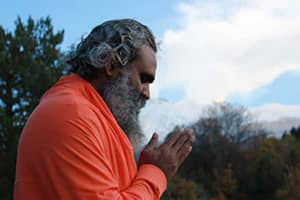
Namaste

You may have heard Namaste said at the end of Yoga class, at an Ashram, or in spiritual communities, but what does it mean? In Sanskrit, Namah or Namas means "bow," therefore the translation is I bow to you. This act also represents the fact that we are all one and have separate experiences.
Namaskar and Namaskaram are another was to say the same thing when greeting another person. In south India, Namaskaram is used and in the north of the country Namaskar is used.
Namaste is used as a casual greeting among people during the course of an average day, while Namaskar or Namaskaram is used for formal settings such as a large gathering or to greet a person of higher status such as religious or political leader.
To start, the hands are brought into Anjali Mudra at Anahata Chakra or the heart. This action is in it's self a show of love from one person to another. The head is bowed which is a show of respect as well as an act of humility upon the practitioner as Namaste is said.
This act is also a way for one person to say to another, I recognize that the God that resides within me, also resides in you and my Soul recognizes your soul. There are several other meanings to Namaste which revolve around the idea of one's essence or soul recognizing another or as a show of greetings, respect and honor from one person to another.
The Sanskrit language is the oldest and one of the most fascinating languages. This is because some of the words represent ideas that do not have an English meaning. Therefore the process of understanding some Sanskrit words can act as a spiritual journey.
We urge you to choose one or two meanings of Namaste that speaks to you and allow it to seep into your core. This can become a practice by it''s self by allowing the meaning to matter more then the practitioner.